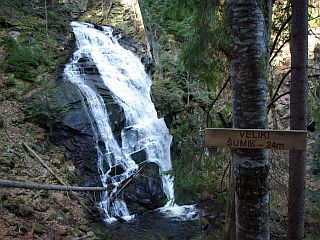
The Šumik Nature Reserve on the edge pf the Pohorje Plateau is a magical landscape of waterfalls and primeval forests. Parts of the landscape are almost untouched by human hands, even though the reserve is just a short drive from Maribor, Slovenia’s second city.
The main attraction of the reserve is the Lobnica Gorge, cut out over millennia by a stream of the same name. Visitors who brave the slippery trail make their way past steep walls covered with moss until they are rewarded with an impressive sight: two magnificent waterfalls in the woods. The larger of the two, Veliki Šumik, is 36 meters high and is one of the most impressive – and water-rich – waterfalls in Slovenia. The smaller waterfall, Mali Šumik, marks the spot from which lumberjacks once used Lobnica’s swift stream to drive logs down to the valley.
As the stream makes its 1000-meter descent through the reserve, it feeds a system of wetlands with abundant plant and animal life. Thanks to the local microclimate, which features both Alpine and Subalpine elements, various rare species thrive in the reserve.
Through the centuries, extensive birch, chestnut, and spruce forests covered the area. Some of the forests were cleared in the 19th century to provide fuel for the burgeoning glassmaking industry of the Pohorje Plateau, but a large stretch of primeval forest – some 19 hectares in area – survives in an inaccessible area above the Lobnica stream.
Even though the local forests have been protected as a nature reserve since 1967, the area remains little known. However, those who do venture into its ancient environment are rewarded with some of eastern Slovenia’s most interesting – and best-preserved – natural landscapes.


































































